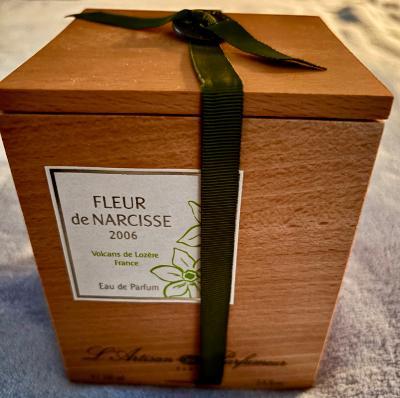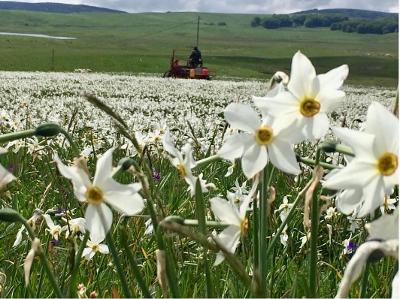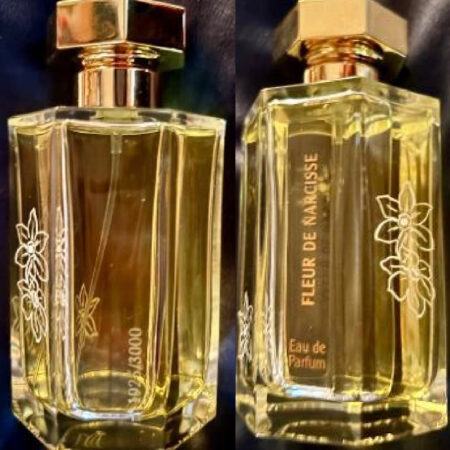
L’Artisan Parfumeur Fleur de Narcisse 2006 in limited edition box by Ida
In perfumery, as in oenology (the study of wine), terroir is everything. All the forces which nature summons – the quality and quantity of sunlight, rain, soil – deeply affect the outcome of treasured crops, be they grapes or flowers. This spectrum of variation ranges from slight and subtle to dramatic; their impact is readily discernible to those who pay close attention. If perfumers do not, who then? In the early portion of the 2000s, L’Artisan Parfumeur decided to release a small limited edition grouping of floral fragrances known collectively as the Harvest Series – four aromatic jewels composed by master perfumer Anne Flipo of IFF. My beloved L’Artisan Parfumeur Fleur de Narcisse 2006 was the second in this collection, following Fleur d’Oranger in 2005 (which was reintroduced in 2007, as it celebrated yet another extraordinary orange blossom harvest from Tunisia, like its predecessor). The final fragrance of this unique array was 2007’s Iris Pallida, which showcased Tuscan iris.

Anne Flipo via Wikipedia
What made these fragrant rarities so exceptional? When you consider that a particular harvest in a specific year may be unrepeatable – that growing conditions might never produce a similarly exquisite absolute – that provides at least a partial answer. Unfortunately, this factor ups the cost considerably – and once the fruits of that harvest are gone, they are gone forever. When L’Artisan Parfumeur composed these perfumes, it resulted in quite a hubbub: some thought that it was a brilliant idea; others were horrified by the price; there were a number of perfumistos who were disappointed because these fragrances were somewhat ephemeral as well as very expensive. A very limited number of bottles were made as well. My current flacon of Fleur de Narcisse is numbered 1925/3000. The house went so far as to engrave each bottle number on its side to better document them.
What possessed me to purchase it in the first place? It wasn’t a question of scarcity or exclusivity; it was that quality which caused my eyes to roll back in my head in olfactory ecstasy. It is rare to experience something so compelling (excepting such anomalies as Guerlain’s Djedi, Hermès’ Doblis, JAR’s Golconda, or Dior’s Diorling, for example) in my life. In fact, I had scrimped and budgeted for a bottle which I eventually gave away (yes!) to someone who was a soulmate; extravagant perhaps, but you had to know the gentleman in order to appreciate why I did it. In time, many years later – a pristine vintage for a reasonable price became available, and I replaced my unique-au-monde flacon without hesitation (it always helps if one can pay in installments). No regrets.

Anne Flipo’s Instagram photograph© (June 2018) of narcissi in Lozère region of southern France
The rich volcanic area of southern France known as Lozère is situated very near the Massif Central – and the world’s renowned narcissi flourish in this landlocked region of Occitanie; not every year produces as splendid and/or copious a crop as the one immortalized by Anne Flipo in her Fleur de Narcisse 2006. To my nose, this eau de parfum is redolent of the hay-like horsiness of barns, the singed smolder of blond tobacco, the inkiest oakmoss. As if this weren’t sufficient, additional animalic nuance is derived from a tart dash of black currant. Some early fragrance experts have posited that they smell vetiver as well, although this note is not mentioned in the brand’s literature. Whatever limpid, aqueous notes are listed impart an enviable transparency; a modicum of mimosa is part of the formula, but so skillfully blended that is challenging to tease it out. As a whole L’Artisan Parfumeur, Fleur de Narcisse does not read as a floral perfume: it is leathery in a most realistic sense. There is a preponderance of botanical materials, which I witness not only upon inhale, but also upon the skin – a sheen which essential oils and absolutes often leave in their wake. It shimmers upon application (so beware of applying it on fine fabrics – it will stain). The brilliant golden hue of this jus is not a cosmetic sleight-of-hand or decorative adjuvant, but a function of the marvelous elements which compose this provocative scent. Fleur de Narcisse 2006 possesses the excellent bone structure and noble breeding which sets it apart from any number of leather fragrances, a fine example of the elegance of fortuitous terroir.

via Ida
Over time, I’ve come to believe that even if price were no object, Fleur de Narcisse 2006 would still have been considered controversial. I harbor no doubt that the current perfume public appreciates great artistry, but sales figures reveal that consumers tend towards fragrances which are tenacious and very often linear: they want a product which remains consistent from start to finish and smells exactly the same way it did when they initially spritzed it, especially if it is advertised as an ultra-luxe, highly exclusive brand. Neither Fleur de Narcisse 2006 nor any of the other L’Artisan Parfumeur Harvest Series fragrances followed this trend; they were mutable as water, changing direction and trajectory, endlessly fascinating.
It’s not easy to come by a sample or decant these days – but if you should come across one in your travels, it provides an instructive journey along one’s quest for olfactive excellence.
Notes: black currant, water notes, narcissus, mimosa, iris, blond tobacco, leather, oakmoss
This perfume is from my personal collection. My nose is my own…
~ Ida Meister, Deputy and Natural Perfumery Editor
Follow us on Instagram @cafleurebonofficial @idameister @lartisanparfumeur @anneflipoparfumeur
This is our Privacy Policy
